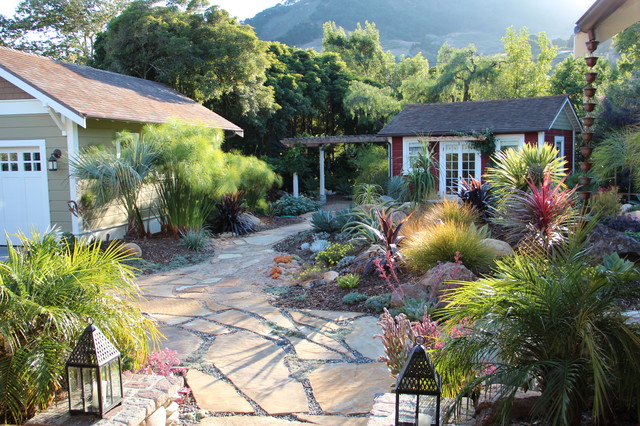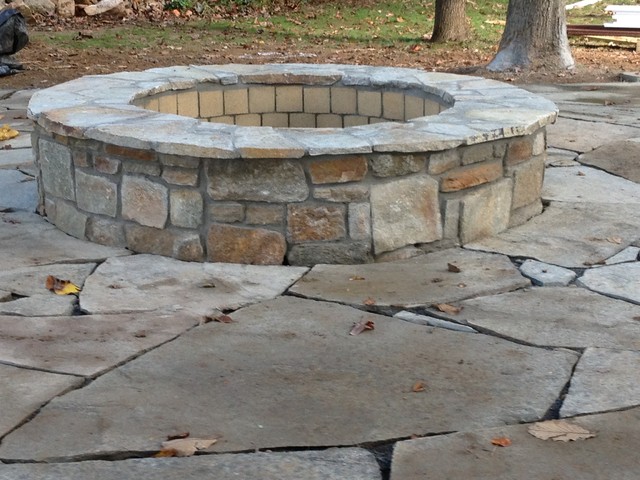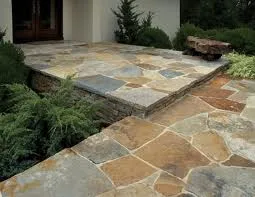Here is some basic flagstone information to get you started, but remember to always check with local experts at a Gainesville landscape company for their recommendations for your particular project.
 Add to ideabook
by Gardens by Gabriel
Practical Considerations
Add to ideabook
by Gardens by Gabriel
Practical ConsiderationsHow it's sold. Gainesville Flagstone, also called patio rock, is sold by the ton or by the pound, not per piece, and the price varies widely depending upon what type of rock the flagstone is. You can expect to pay anywhere from $140 to $320-plus per ton. The more exotic the rock, the higher the cost, so if your budget is tight, look for a common flagstone that is quarried locally.
Thickness. You will likely flagstone described as thick or thin, and which one you should buy depends upon how you want to use it.
If you intend to lay a flagstone pathway without mortar, you will want to get thick pieces, or those that are 2 inches in height. Thin flagstone is less than 2 inches thick and will crack and break apart if not set into a mortared base. Thicker pieces are also often called "lay-down," because you can lay them directly down on the soil without mortar. Larger and thicker pieces are sometimes called "stand-up," because they can stand on their sides in a rack.
 Add to ideabook
by Jeffrey Gordon Smith Landscape Architecture
How to pick flagstone. If you are mortaring it in to create a Gainesville patio, you can use a wide variety of sizes, but if you want to have a nonmortared pathway, it's best to use pieces at least 2 feet wide.
Add to ideabook
by Jeffrey Gordon Smith Landscape Architecture
How to pick flagstone. If you are mortaring it in to create a Gainesville patio, you can use a wide variety of sizes, but if you want to have a nonmortared pathway, it's best to use pieces at least 2 feet wide. Flagstone is often organized by type and then packed onto pallets that are wrapped in chicken wire to keep it all together — ask your rock yard if you can cherry-pick the pieces you want from each pallet. Some rock yards prohibit this practice, asking instead that you purchase an entire pallet or cherry-pick only from pallets that have already been opened (meaning the chicken wire has been cut or removed).
How much do you need? That depends upon your project, but start with calculating the square footage of your path or patio. A 10- by 20-foot patio, for example, is 200 square feet. Next determine what the coverage is for the material you are using. "Coverage" simply means how much area your material will cover — your rock-yard staff should be able to give you that information.
There is a formula to figure out how much material you will need: the square footage of the project (200) divided by the square footage of the coverage (say, 100) equals the tons of material required (2 tons). So you would need 2 tons of flagstone to make a 10- by 20-foot patio.
 Add to ideabook
by mark pinkerton - vi360 photography
How to Use Flagstone
Add to ideabook
by mark pinkerton - vi360 photography
How to Use FlagstoneGainesville Patios. Flagstone is a favorite material for creating outdoor gathering spaces like landscape patios. It's possible to lay flagstone on a sand bed and then fill in the joints with gravel for a very casual look, but if you want something longer lasting, you'll have to pull out the big guns. That means laying the flagstone on concrete and then mortaring the joints. You can't simply lay the flagstone on the ground and mortar the joints — this is a poor practice that leads to cracked joints and an unstable and unsightly patio. These types of projects are better left to the Gainesville landscape professionals.
 Add to ideabook
by Jeffrey Gordon Smith Landscape Architecture
Seating. Seating can be created by stacking mortared flagstone to the desired height (typically 18 to 22 inches), then capping the stack off with a smoother capstone that is comfortable to sit on.
Add to ideabook
by Jeffrey Gordon Smith Landscape Architecture
Seating. Seating can be created by stacking mortared flagstone to the desired height (typically 18 to 22 inches), then capping the stack off with a smoother capstone that is comfortable to sit on. Low seating walls like these work well on the edges of patios or around fire pits. You can match the flagstone that is in your patio for a monochromatic, seamless look, or you can use a different type of flagstone for a contrasting appearance. It's a little tricky to construct level and secure seating, so I recommend hiring a crew to build your flagstone seating wall.
 Add to ideabook
by debora carl landscape design
Steps. Flagstone steps in the garden create a very organic, natural look and can last for many years if built correctly. Unless the flagstone you are using is very big and thick, you will most likely need to mortar the pieces in place to create stable and secure steps. This is not a place where you can afford to have any shifting; people will be walking up and down these steps, after all. If you are dealing with a very sloping part of your landscape, it's best to hire pros to make sure the steps are built securely.
Add to ideabook
by debora carl landscape design
Steps. Flagstone steps in the garden create a very organic, natural look and can last for many years if built correctly. Unless the flagstone you are using is very big and thick, you will most likely need to mortar the pieces in place to create stable and secure steps. This is not a place where you can afford to have any shifting; people will be walking up and down these steps, after all. If you are dealing with a very sloping part of your landscape, it's best to hire pros to make sure the steps are built securely.
 Add to ideabook
by Jeffrey Gordon Smith Landscape Architecture
Gainesville Retaining walls. Retaining walls are necessary when you have a slope, or when you'd like to create a grade change for a more dramatic appearance in your Gainesville landscape installation. They are called retaining walls because they retain soil on one side.
Add to ideabook
by Jeffrey Gordon Smith Landscape Architecture
Gainesville Retaining walls. Retaining walls are necessary when you have a slope, or when you'd like to create a grade change for a more dramatic appearance in your Gainesville landscape installation. They are called retaining walls because they retain soil on one side. Be sure to check your local city code for guidelines on creating retaining walls, as walls over a certain height — 3 feet for example — may need to be planned by a Gainesville landscape designer or structural engineer. The last thing you want is a failed retaining wall that poses a safety risk and leads to an expensive repair, so many of these types of projects are best left to the professionals.
 Add to ideabook
by Exteriorscapes llc
Pathways. Just when you think there may be no DIY project dealing with flagstone, along comes the garden pathway! Many of the same guidelines that are suggested for laying flagstone patios also apply to pathways — namely, if you are using 2-inch-thick large pieces, you can lay them down on the ground without mortar, but thinner pieces will need to be set in concrete for stability and longevity.
Add to ideabook
by Exteriorscapes llc
Pathways. Just when you think there may be no DIY project dealing with flagstone, along comes the garden pathway! Many of the same guidelines that are suggested for laying flagstone patios also apply to pathways — namely, if you are using 2-inch-thick large pieces, you can lay them down on the ground without mortar, but thinner pieces will need to be set in concrete for stability and longevity. Set your pieces out in a mosaic pattern, as shown, or arrange them end to end for a narrower pathway. Be sure to take a walk on your pathway before finishing the project to ensure that the spacing of your stones leads to a natural gait when you walk. If you are laying the stones without concrete or mortar, fill the gaps between them with mulch, pea gravel or plants that can be stepped on, like thyme or sedum.
 Add to ideabook
by Urban Gardens Inc.
Fire pits. Fire pits are a wonderful gathering area, and constructing a fire pit out of flagstonecan create a very organic and natural appearance. Depending upon the design of your desired fire pit, this can be a DIY project or one that is commissioned out to a masonry or landscape crew.
Add to ideabook
by Urban Gardens Inc.
Fire pits. Fire pits are a wonderful gathering area, and constructing a fire pit out of flagstonecan create a very organic and natural appearance. Depending upon the design of your desired fire pit, this can be a DIY project or one that is commissioned out to a masonry or landscape crew. The interior of a flagstone fire pit is constructed with fireproof materials (cinderblock, for example), and the exterior is finished with mortared flagstone. This would not be a project for a first-timer, however, particularly if you want a round fire pit like the one here.
Jenny Peterson is a landscape columnist for Houzz.com. Read the original at http://www.houzz.com/ideabooks/11833075/list?utm_source=Houzz&utm_campaign=u292&utm_medium=email&utm_content=gallery7

